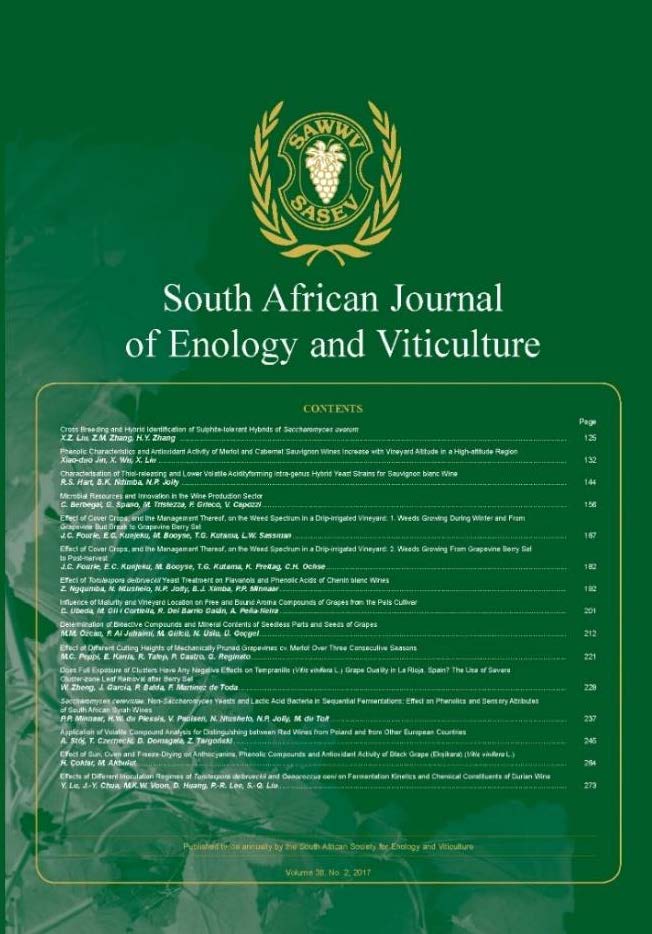Effect of Cover Crops, and the Management Thereof, on the Weed Spectrum in a Drip-irrigated Vineyard: 2. Weeds Growing From Grapevine Berry Set to Post-harvest
DOI:
https://doi.org/10.21548/38-2-1354Abstract
A five-year trial (2009 to 2013) was executed in a drip-irrigated seven-year-old Shiraz/101-14 Mgt vineyard established on a sandy to sandy clay loam soil at Blaauwklippen Farm (33°58’S, 18°50’E) near Stellenbosch, South Africa. Fourteen treatments, consisting of two management practices applied to five cover crop species, as well as winter-growing weeds (no cover crop) and winter-growing weeds (no cover crop) with nematicide applied in the vine row, were applied. The weeds and cover crop species were eithercontrolled chemically (CC) or mechanically (MC) during grapevine bud break, followed by full-surface chemical control during berry set (for both CC and MC treatments). Rhynchelytrum repens (Natal redtop)dominated the post-harvest pre-treatment weed spectrum in all the treatments except Eruca sativa cv. Nemat (Nemat) (MC). This species lost its post-harvest dominance from 2010 onwards. It seems that the relatively low summer rainfall during the 2010/2011 season allowed Anagallis arvensis to appear in April 2011 and dominate some of the treatments, which coincided with the disappearance of Cynodon dactylon (common couch) and Polygonum aviculare (prostrate knotweed). Digitaria sanguinalis, common couch and prostrate knotweed seemed to establish better during late summer where MC was applied. The pre-treatment average post-harvest weed stand of 5.53 t/ha was reduced to 0.53 t/ha within one season, illustrating the benefit of full-surface chemical weed control applied during grapevine berry set.Downloads
References
Cousens, R. & Mortimer, M., 1995 (1st ed). Dynamics of weed populations. Cambridge University Press, Cambridge.
Fourie, J.C., 2005. Cover crop management in the vineyards of the Lower Orange River region, South Africa: 1. Performance of grass and broadleaf species. S. Afr. J. Enol. Vitic. 26, 140-146.
Fourie, J.C., 2010. Soil management in the Breede River Valley wine grape region, South Africa. 1. Cover crop performance and weed control. S. Afr. J. Enol. Vitic. 31, 14-21.
Fourie, J.C., Kruger, D.H.M. & Malan, A.P., 2015. Effect of management practices applied to cover crops with bio-fumigation properties on cover crop performance and weed control in a vineyard. S. Afr. J. Enol. Vitic. 36, 146-153.
Fourie, J.C., Kunjeku, E.C., Booyse, M., Kutama, T.G., & Sassman, L.W., 2017. Effect of cover crops, and the management thereof, on the weed spectrum in a drip irrigated vineyard. 1. Weeds growing during winter and from grapevine bud break to grapevine berry set. S. Afr. J. Enol. Vitic., submitted for publication.
Fourie, J.C., Louw, P.J.E. & Agenbag, G.A., 2001. Effect of seeding date on the performance of grasses and broadleaf species evaluated for cover crop management in two wine grape regions of South Africa. S. Afr. J. Plant Soil 18, 118-127.
Fourie, J.C., Louw, P.J.E. & Agenbag, G.A., 2005. Cover crop management in a Sauvignon blanc/Ramsey vineyard in the semi-arid Olifants River Valley, South Africa. 1. Effect of management practices on selected grass and broadleaf species. S. Afr. J. Enol. Vitic. 26, 131-139.
Fourie, J.C., Louw, P.J.E. & Agenbag, G.A., 2006. Cover crop management in a Chardonnay/99 Richter vineyard in the Coastal wine grape region, South Africa. 1. Effect of two management practices on selected grasses and broadleaf species. S. Afr. J. Enol. Vitic. 27, 167-177.
Légère, A. & Samson, D.N., 1999. Relative influence of crop rotation, tillage and weed management on weed associations in spring barley cropping systems. Weed Sci. 47, 112-122.
Ott, R.L. & Longnecker M. 2001. An Introduction to Statistical methods and data analysis. 5th Edition Belmont, California:Duxbury Press: p 440 (pp 1-1152).
Shapiro, S.S. & Wilk, M.B., 1965. An analysis of variance test for normality (complete samples). Biometrika 52, 591-611.
Shrestha, A., Knezevic, S.Z., Roy, R.C. & Ball-Coelho, B.R., 2002. Effect of tillage, cover crop and crop rotation on the composition of weed flora in a sandy soil. Weed Res. 42, 76-87.
Westra, P., Wilson, R.G., Miller, S.D., Stahlman, P.W., Wicks, G.W., Chapman, P.L., Withrow, J., Legg, D., Alford, C. & Gaines, T.A., 2008. Weed population dynamics after six years under glyphosate- and conventional herbicide-based weed control strategies. Crop Sci. 48, 1170-1177.
Downloads
Published
Issue
Section
License
A copyright form will be e-mailed to the corresponding author when the manuscript has been accepted for publication.
In principle, the Author agrees to the following when he/she signes the copyright agreement:
I hereby assign to the SOUTH AFRICAN SOCIETY FOR ENOLOGY AND VITICULTURE (SASEV) the copyright of the text, tables, figures, supplementary material, illustrations and other information (the Material) submitted with the manuscript to be published in SOUTH AFRICAN JOURNAL OF ENOLOGY AND VITICULTURE (SAJEV) (the "Article"). The copyright becomes effective from the date the Article has been accepted for publication in SAJEV.
This is an open access journal, and the authors and journal should be properly acknowledged, when works are cited.
Author's may use the publishers version for teaching purposes, in books, theses, dissertations, conferences and conference papers.
A copy of the authors' publishers version may also be hosted on the following websites:
- Non-commercial personal webpage or blog.
- Institutional webpage.
- Authors Institutional Repository.
The following notice should accompany such a posting on the website: This is an electronic version of an article published in SAJEV, Volume XXX, number XXX, pages XXX - XXX, DOI. Authors should also supply a hyperlink to the original paper or indicate where the original paper (www.journals.ac.za/index.php/sajev/) may be found.
Authors publishers version, affiliated with the Stellenbosch University will be automatically deposited in the University's Institutional Repository SUNScholar.
Articles as a whole, may not be re-published with another journal.
The following license applies:
Attribution CC BY-NC-ND 4.0

